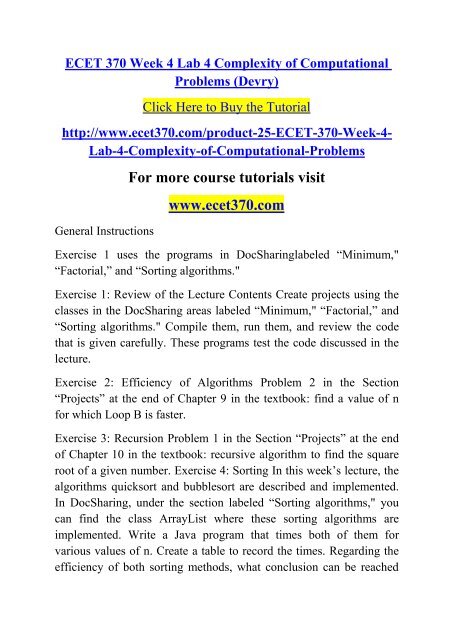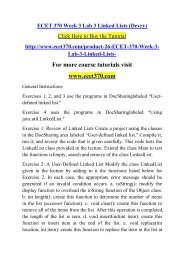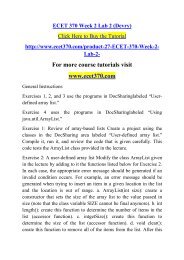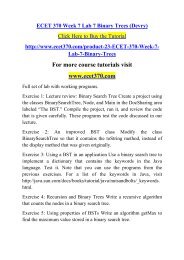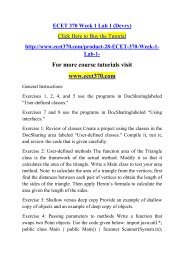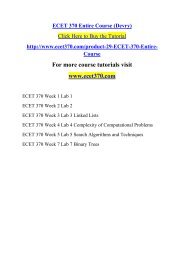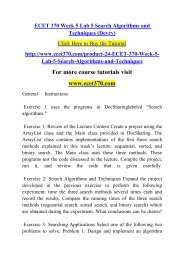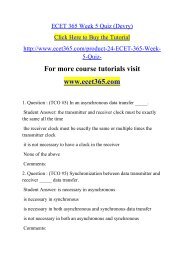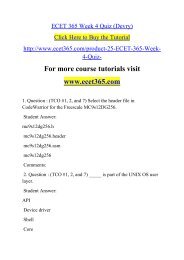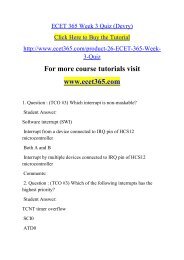ECET 370 Week 4 Lab 4 Complexity of Computational Problems (Devry).pdf
For more course tutorials visit www.ecet370.com General Instructions Exercise 1 uses the programs in DocSharinglabeled “Minimum," “Factorial,” and “Sorting algorithms." Exercise 1: Review of the Lecture Contents Create projects using the classes in the DocSharing areas labeled “Minimum," “Factorial,” and “Sorting algorithms." Compile them, run them, and review the code that is given carefully. These programs test the code discussed in the lecture. Exercise 2: Efficiency of Algorithms Problem 2 in the Section “Projects” at the end of Chapter 9 in the textbook: find a value of n for which Loop B is faster. Exercise 3: Recursion Problem 1 in the Section “Projects” at the end of Chapter 10 in the textbook: recursive algorithm to find the square root of a given number. Exercise 4: Sorting In this week’s lecture, the algorithms quicksort and bubblesort are described and implemented. In DocSharing, under the section labeled “Sorting algorithms," you can find the class ArrayList where these sorting algorithms are implemented. Write a Java program that times both of them for various values of n. Create a table to record the times. Regarding the efficiency of both sorting methods, what conclusion can be reached from this experiment? Note: You can probably save development time by using the program from Week 2 to generate a list of the 1000 smallest prime numbers (in random order). This list could then be used as the input to the sorting algorithms.
For more course tutorials visit
www.ecet370.com
General Instructions
Exercise 1 uses the programs in DocSharinglabeled “Minimum," “Factorial,” and “Sorting algorithms."
Exercise 1: Review of the Lecture Contents Create projects using the classes in the DocSharing areas labeled “Minimum," “Factorial,” and “Sorting algorithms." Compile them, run them, and review the code that is given carefully. These programs test the code discussed in the lecture.
Exercise 2: Efficiency of Algorithms Problem 2 in the Section “Projects” at the end of Chapter 9 in the textbook: find a value of n for which Loop B is faster.
Exercise 3: Recursion Problem 1 in the Section “Projects” at the end of Chapter 10 in the textbook: recursive algorithm to find the square root of a given number. Exercise 4: Sorting In this week’s lecture, the algorithms quicksort and bubblesort are described and implemented. In DocSharing, under the section labeled “Sorting algorithms," you can find the class ArrayList where these sorting algorithms are implemented. Write a Java program that times both of them for various values of n. Create a table to record the times. Regarding the efficiency of both sorting methods, what conclusion can be reached from this experiment? Note: You can probably save development time by using the program from Week 2 to generate a list of the 1000 smallest prime numbers (in random order). This list could then be used as the input to the sorting algorithms.
- TAGS
- ecet
- complexity
- computational
Create successful ePaper yourself
Turn your PDF publications into a flip-book with our unique Google optimized e-Paper software.
from this experiment? Note: You can probably save development timeby using the program from <strong>Week</strong> 2 to generate a list <strong>of</strong> the 1000smallest prime numbers (in random order). This list could then beused as the input to the sorting algorithms.


